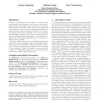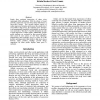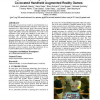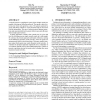327 search results - page 17 / 66 » How to Evaluate Social Intelligence Design |
DRM
2007
Springer
14 years 2 months ago
2007
Springer
The goal of obfuscation is to transform a program, without affecting its functionality, such that some secret information within the program can be hidden for as long as possible...
ICWSM
2008
13 years 10 months ago
2008
People form consistent impressions of others given surprisingly little information. With the advent of social networks, impressions now may form online rather than in a face-to-fa...
ACMACE
2008
ACM
13 years 10 months ago
2008
ACM
In this paper, we present our research on social interaction in colocated handheld augmented reality (AR) games. These games are characterized by shared physical spaces that promo...
ATAL
2003
Springer
14 years 1 months ago
2003
Springer
A referral system is a multiagent system whose member agents are capable of giving and following referrals. The specific cases of interest arise where each agent has a user. The ...
ATAL
2006
Springer
14 years 10 days ago
2006
Springer
In many Multi-Agent Systems (MAS), agents (even if selfinterested) need to cooperate in order to maximize their own utilities. Most of the multi-agent learning algorithms focus on...




